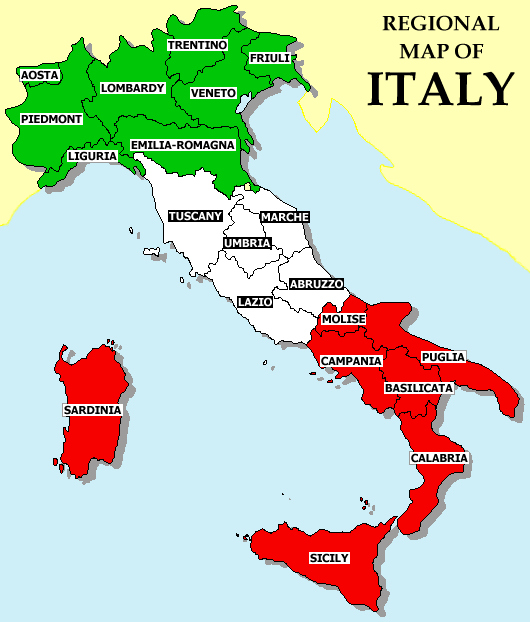
Üçüncü İtalya, İtalya'nın zengin olan kuzey bölgesi ile fakir olan güney bölgesi arasında kalan,
küçük ve orta büyüklükteki işletmeler ile yani bir işletmecilik anlayışı ile bölgenin kalkınmasına katkı sağlayan şehirleri ifade etmektedir. Postfordist bir yaklaşımı ifade eden bu bölge, silikon vadileri ve sanayileşen kitlesel faaliyetleri gibi faaliyet göstermektedir.
Background InformationThree Italies, not twoTraditionally, geographers have viewed Italy as divided in two - rich North, poor South. But this view is no longer accurate. Economic development has begun to transform a new region of Italy - the Third Italy.This Third Italian region is in the north-east of the country. It's an area of stunning beauty, bordered by the historic city of Venice and the Adriatic coast to the south and east, and by the Alps and the Dolomites which overlook Italy's northern border. This region lies south of Switzerland, Austria, and Slovenia. It extends approximately 450 km down the eastern coast of Italy and about 300 km inland. At its centre is the regional capital of Bologna, and scattered around are towns like Parma (where the famous ham comes from) and Pisa with its leaning tower.New industrial and commercial regionsIn most MEDCs (More Economically Developed Countries) something similar is happening. Silicon Valley in California, the Sun Belt Cities in the American deep south, and the M4 corridor in the UK, have much in common. In the last twenty years, these regions have seen what all the countries in the European Union have been experiencing: a shift away from farming and heavy industry towards light industry and service businesses.Key features of the Third ItalySeveral characteristics of the Third Italy can be discerned. In the first place, the region has been transformed by tens of thousands of small and medium-sized businesses which have established themselves here over the last twenty years. Light industrial estates are sprinkled around prospering provincial towns, such as Treviso, 30 km north of Venice.Many businesses are small enough to fit into factory units that look remarkably like ordinary houses. It is in premises like these that people produce all manner of products and services. They prefer to work for themselves, rather than for the huge companies that have dominated Italy's industrial past.Another characteristic of many of the businesses here in the Third Italy is their ability to spot new markets and exploit them before their competitors. Roces is a good example. The company started in the 1930s making hiking boots, and now manufactures a wide range of stylish sporting equipment, including inline skates. Roces' staff find that developing new ideas is a lot easier when there are people around them who are supportive. In the Third Italy, many companies are family-run, and everyone seems to know everyone else in business around them. Roces believe there is a mutual advantage in contracting companies they know to make the smaller components they need.Furthermore, while employment is local, the market is global. Roces skates are sold worldwide, which means the company is not so exposed to risk if the local economy weakens. And in a global market they are convinced that their modest size combined with their close family and business ties gives them an advantage that helps them compete with the best.BenettonThis company also started locally on a small scale. Even now, as a multinational with a huge factory just outside Treviso, it exemplifies much of what the Third Italy stands for.Like Roces, Benetton also contracts smaller companies in the area to carry out many of its manufacturing processes - but on a much larger scale. These so-called 'industrial links' with smaller companies transfer Benetton's success into the local economic chain, generating more work by what is known as the 'multiplier effect'.Tex Control is one company that has benefited from its industrial link with Benetton. It handles many of the dyeing operations for the Benetton jean and knitwear ranges.Research and development, using talented employees from around the world, is central to Benetton's business success. It is also typical of the Third Italy approach. At an imposing Romanesque villa outside Treviso, Benetton have set up Fabrica, a hothouse of art and design, which attracts the cream of artists from all over Europe.Carmen Heinemann, for example, came from Germany a year ago to work at Fabrica. As a citizen of the EU, she can live and work freely in Italy. Carmen is a graphic designer who is sponsored by Benetton to immerse herself in creativity and ideas. She sees the idea of Fabrica as symbolising Benetton's wish to bring a lot of people together, not only from different nations but also from different disciplines. So at Fabrica there are architects, musicians, graphic designers, photographers and web designers, who all work on projects together.
Kaynaklar:
https://myworldguide.files.
http://www.channel4.com





















Hiç yorum yok:
Yorum Gönder